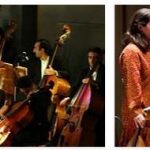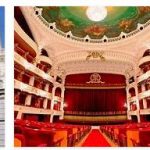A modest documentary activity develops following the first projections of the Cinematografo Lumière, which took place in Buenos Aires in July 1896. In 1908 the first feature film, El fusilamiento de Dorrego by the Italian M. Gallo, was released, which paved the way for the series of historical reconstructions. With Nobleza gaucha (1915), a great success of the 1910s, part of the production is oriented towards themes, aspects and characters of Argentine popular life. JA Ferreyra, the most important personality of the silent period, has been active since 1915.
The advent of sound, in 1931, led to the spread of a typically Argentine genre, the tango film. During the Thirties, production was organized on an industrial basis, conquering the Latin American market with works that imitate Hollywood models, the star system and forms of escapist cinema. In this panorama two directors, M. Soffici and L. Torres Rios, stand out for the originality of a poetics inspired by realism and the deep roots of national culture.
In the immediate post-war period, the shortage of film worsened the crisis, which was already rampant, and production marched to minimum levels, losing Latin American markets. The protectionist measures adopted by the Peron government since 1944 rebalance the precarious economic situation, without giving it new impetus. At the same time the quality level of the films is lowered and the end of Peronism, in 1955, leaves Argentine cinema in full decline, forcing many directors and technicians to emigrate.
However, three important authors work in this period such as L. Torre Nilsson, F. Birri, F. Ayala, and a new generation of filmmakers begins to come forward, formed within film clubs, specialized magazines and documentary filmmaking. In the mid-1950s, experimental cinema associations were born and the Instituto de Cinematografia of Santa Fe was founded, under the direction of F. Birri. In 1958-59 the Institute produced Tire-Dié, a social documentary which is considered the birth certificate of the new Argentine cinema. A different cinematic awareness has now established itself, rooted in the social, cultural and political reality of the nation.
The Frondizi government seems to encourage this independent production by enacting a law on cinema and creating the Instituto Nacional de Cinematografia in 1957. This is how the renewal work proceeded throughout the early 1960s, in harmony with the European and South American nouvelles vagues, but soon the movement found itself dealing with the closures of industry and the market. When Ogania’s coup d’état takes place, in 1966, production has already returned to the old forms of escape cinema and the only important voice in the commercial circuit is represented by the director L. Favio.
According to searchforpublicschools, the military dictatorship provokes the rise of a clandestine cinema, aligned with the resistance. In this context, O. Getino and FE Solanas made, in 1968, La hora de los hornos, a revolutionary propaganda film that could be distributed only after the return of Peronism to power. The short period of political liberalization opened by Perón corresponds to a moment of industrial, as well as cultural, revival of national cinema, now protected by new laws. Patagonia rebelde was released in 1973, a tale of a peasant strike in the 1920s, shot by H. Olivera. In 1974 S. Rena’n realizes the first Argentine film that receives the nomination for the Oscar, The Truce, story of the encounter between a priest and a young woman. In 1975 JJ Jusid directed Los guachos Judios, which has as its subject the Jewish immigration in Argentina at the end of the last century. The coup d’état of 1976 put an end to this renaissance by forcing many Argentine directors into exile. Among those who remain to fight against censorship and persecution, Argentina Aristarain represents the most prominent personality.
The return to democracy in 1983 coincides with the opening of a new expansive course, repeating a dynamic that is now familiar in the history of Argentine cinema. An important director like M. Antin takes over the direction of the Instituto Nacional de Cinematografia and in three years manages to triple production, favoring young authors first of all. Argentine cinema is now experiencing a new season of glory by collecting international awards and recognitions with works such as No habrá más penas ni olvido, a political satire by H. Olivera on the last months of the Peronist dictatorship; La historia oficial, by L. Penzo, which deals with the tragedy of the desaparecidos ; Camila and Miss Mary, two portraits of women signed by ML Bemberg; Tangos by FE Solanas, on the Argentine exiles in Paris; La película del rey by C. Sorín, on the grotesque story of a director struggling with his film; Hombre aiming at the southeast, a science fiction film directed by E. Subiela.






